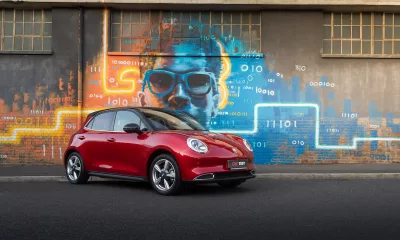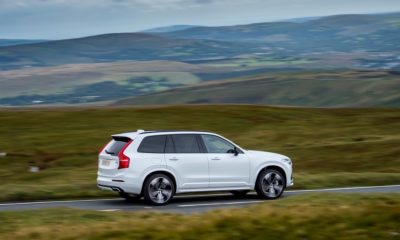WONDER what that green button is for? It must be pretty important, because it’s positioned on the steering wheel in perfect striking distance of the driver’s thumb, just like the red “fire” button on a fighter pilot’s joystick.
We’re standing eyeball to eyeball with the “little” Volkswagen Polo rally car that a week earlier finished its final South African National Rally Championship event of the year. The car is “as is” after leaving the Tzaneen Rally, except for one very important detail – where during the rally there was a large number 2 pasted on the side of the car, that has now been replaced by the number 1. Important because it denotes that this is the car that carried driver Jan Habig and his navigator, Douglas Judd, to their 2005 overall national championship victory.
Below the new number is displayed another significant letter and number, a symbol that is shared with the competition. 2005 has been the first year in which the South African Rally Championship has been run to the new FIA S2000 regulations, an attempt by the governing body of motorsport to create one common worldwide class of rallying. In doing this, the FIA hopes to be able to control the ever-escalating costs involved in the sport and, at the same time, level the playing field by making all the machinery conform to strict rules and regulations. Regulations that make winning the championship tougher but all the sweeter.
The BP-sponsored Polo S2000 looks ready for anything this morning. The smaller body of the baby Volkswagen looks more squat and agile than the Golf 4 used in previous campaigns (and still being rallied in other classes), not to mention lighter. With regulations stating a minimum weight requirement of 1 150 kg, the Polo tips the scales, unladen, with only 20kg to spare. And weight-saving is, of course, an all-important consideration when competing at the trophy end of the leader board. Hand-in-hand with this is the distribution of said weight. Which is the reason why Mr Judd’s navigation seat, into which I’ve just clambered, is positioned so low down in the car. Why would he need to see where the car is going anyway? The Polo also conveniently meets the overall length stipulation by only a coat of paint, and, because Volkswagen SA produces more than the required 25 000 of the little model per year, it fully complies with the S2000 requirements.
On the short drive on public roads to the test track at Volkswagen’s Uitenhage home base, the Polo looks like a customiser’s dream as the huge flared wheel arches, roof-mounted air scoop and air ventilation holes in the bonnet deliver a statement of intent. Had this been a custom job, there would no doubt have been a much bigger wing stuck on the back, and while there could actually be some additional practical advantage to be derived from this, the regulations state, among other things, that the fixed wing may not protrude further than the rear bumper or higher than the roof line – a customiser’s nightmare! However, the huge boom from the exhaust would certainly redeem some street cred.
Pulling away from a traffic light with a few hops and jumps reveals one more very important characteristic of the cars brought in by the S2000 regulations this year. All the contenders in this class have a centre differential that apportions drive to all four wheels. A device that isn’t too keen on slow and steady pulloffs on hard ground. The Polo shares its prop shaft tunnels with its Skoda WRC cousin.
The interior reveals only the required minimum level of standard fittings that would be found in the showroom Polo, while the rest is pure rally-ready equipment. In the space that’s reserved for your factory fitted radio, between the standard air vents and climate controls in the centre console, the rally car houses an array of fuses for the various electrical gadgets, in a sheet of carbonfibre. Not being big on saying thank you by using hazard lights, and not being allowed to use traction control, frees up more space on the centre dash for a row of toggle switches for operating spot lights, interior fans and switching between fuel pumps.
The original indicator and windscreen wiper stalks are still present and in working order, but their normal housing has been tossed, and they now flank a racing steering wheel – with that green button. From the driver’s seat, the digital instrument display ahead is dominated by the in-gear readout and the speedometer, with a rev-counter display running along the top.
Down below, three drilled, floormounted pedals protrude from the carbon fibre floor-board and stand out against the bare metal of the footwell. The pedal on the right is tasked with translating Mr Habig’s go-faster desires to the normally aspirated, four-cylinder, 2,0-litre engine mounted at a regulated maximum tilt of 25 degrees towards the driver. Using the Volkswagen Group’s 2,0-litre block (currently offered in the 96 kW Audi A4) the company’s Lichtenstein-based tuners, Lehmann Motorentechnik, have developed a lightweight unit that generates 195 kW of fuel-injected power at 8 250 r/min and 235 N.m of torque at 7 000 r/min. A large, hand-built air intake manifold surrounded by individual oil cooler tubes for nearly every major sub assembly, including power steering, differential and gearbox, dominates the view under the bonnet.
On the concrete test track, still with its Dunlop Direzza DZ86RW gravel tyres mounted to 15-inch x 6,5J alloys, the huge grip levels made for a slightly delayed getaway, but the S2000 Polo was still able to sprint past the 100km/h mark in just 6,31 seconds, and charged on to complete the kilometre in 27,38 seconds. Split-second gear-changes courtesy of the sequential gearbox – with push/pull lever mounted high up to the left of the steering wheel – help keep the engine on the boil. This lever works hard during each rally stage, and the AP Racing twin plate clutch suffers the consequences, as its average lifespan is a mere 600 stage kilometres. On our test day the clutch used in the last victorious outing was allowed a swansong appearance, and this was surely to blame for the first stall on the line once our tester was allowed to take Jan Habig’s place in the hot seat.
Second time lucky, and the run through the gears reveals a remarkably smooth power curve that doesn’t seem to want to flatten once the loud end of sixth gear has been reached. A top speed reading of 172 km/h is almost meaningless in the context that most of a rally stage would be driven with the gearing suited to low speed acceleration and car control, as demonstrated by the new champion himself on a gravel section of the test track during our photo shoot.
MacPherson struts are the regulated suspension type for S2000 rally cars. The Volkswagen crew runs them with Reiger dampers, coil springs and fabricated wishbones front and rear. Anti-roll bars are fitted at both ends. This provides the preferred compromise between rigidity and absorp tion of the big bumps experienced over stages. The minor yump negotiated at the test track demonstrates just how well-engineered the suspension really is. Even with all four wheels leaving the ground, the landing was smooth and effortless.
The centre pedal in the driver’s foot well controls substantial braking ability. With 300 mm ventilated discs and four-piston Alcon calipers all round, we were able to come to a complete stop, from 100km/h, in just 3,0 seconds.
Now a five-time South African Rally Champion, Habig says that this is the best rally car he’s ever driven. No doubt his sponsors won’t be quibbling over the 50 litres per hundred stage kilometre fuel consumption figures. For the competition, the news is that next year’s car, with the new Polo family face attached, is proving during testing to be even better, thanks to improved air circulation over the new nose.
And that green button mounted on the steering wheel? – “Cleans the windscreen!”






